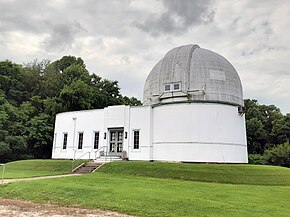The Goethe Link Observatory, observatory code 760, is an astronomical observatory near Brooklyn, Indiana, United States.[1] It is owned by Indiana University and operated by the Indiana Astronomical Society https://iasindy.org/about.html, which efforts are dedicated to the pursuit of amateur astronomy.[2]
 | |||||||
| Organization | Indiana University (Indiana Astronomical Society) | ||||||
|---|---|---|---|---|---|---|---|
| Observatory code | 760 | ||||||
| Location | Brooklyn, Indiana, U.S. | ||||||
| Coordinates | 39°33′00″N 86°23′42″W / 39.55000°N 86.39500°W | ||||||
| Altitude | 293 metres (962 ft) | ||||||
| Weather | Clear Sky Clock | ||||||
| Established | 1939 | ||||||
| Website | iasindy | ||||||
| Telescopes | |||||||
| |||||||
Observatory Address: 8403 Observatory Ln, Martinsville, IN 46151.
Hours: During and after General Meetings of the Indiana Astronomical Society (IAS). See https://iasindy.org/events.html, for dates and times.
It is named in honor of amateur astronomer Dr. Goethe Link, an Indianapolis surgeon, who built it with his private funds. Construction of the observatory started in 1937, and the telescope was first operated in 1939. In 1948, he donated the observatory to Indiana University.[1]
From 1949 until 1966, the Indiana Asteroid Program was conducted at Goethe Link, using a 10-inch Cooke triplet astrograph (f/6.5).[3] The program resulted in the discovery of 119 asteroids, which were credited by the Minor Planet Center to "Indiana University".[4]
When light pollution began to degrade the Goethe Link Observatory's capabilities in the 1960s, Indiana University built a new facility in the Morgan–Monroe State Forest officially designated as the Morgan–Monroe Station (MMS) of the Goethe Link Observatories.[5][6] IU operated that facility through about 2014. Today, Indiana University primarily uses the WIYN 3.5-m and 0.9-m telescopes located at the Kitt Peak National Observatory near Tucson, AZ for ongoing research.[7]
The naming of the two main-belt asteroids, 1602 Indiana and 1728 Goethe Link – both discovered at Goethe Link Observatory in 1950 and 1964, respectively – is related to the Observatory and its parent institution.[8][9]
See also
editReferences
edit- ^ a b "The Goethe Link Observatory". Indiana Astronomical Society. Retrieved 29 December 2016.
- ^ "Homepage of the Indiana Astronomical Society". Indiana Astronomical Society. Retrieved 29 December 2016.
- ^ Gehrels, Thomas (February 1958). "The Indiana asteroid program". Astronomical Journal. 63: 50. Bibcode:1958AJ.....63...50G. doi:10.1086/107684.
- ^ "IU Asteroid Program "records" final chapter". Indiana University – News Room. 7 April 2008. Retrieved 29 December 2016.
- ^ "Department of astronomy – Morgan–Monroe Observatory". Indiana University Bloomington. Retrieved 29 December 2016.[permanent dead link]
- ^ "Department of astronomy – Research Facilities". Indiana University Bloomington. Archived from the original on 27 April 2019. Retrieved 29 December 2016.
- ^ "Indiana Astronomical Society". iasindy.org. Retrieved 2019-08-26.
- ^ Schmadel, Lutz D. (2007). "(1602) Indiana". Dictionary of Minor Planet Names – (1602) Indiana. Springer Berlin Heidelberg. p. 127. doi:10.1007/978-3-540-29925-7_1603. ISBN 978-3-540-00238-3.
- ^ Schmadel, Lutz D. (2007). "(1728) Goethe Link". Dictionary of Minor Planet Names – (1728) Goethe Link. Springer Berlin Heidelberg. p. 137. doi:10.1007/978-3-540-29925-7_1729. ISBN 978-3-540-00238-3.
Further reading
edit- Ray E. Boomhower, '"The Doctor and the Stars: Goethe Link and His Observatory," Traces of Indiana and Midwestern History, v. 19, no. 4, Fall 2007, pp. 17–23.
- Frank K. Edmondson, "Recent Developments at the Goethe Link Observatory," Sky and Telescope, December 1948, p. 34.
- "Reports of Observatories, 1950-1951: Goethe Link Observatory, July 1, 1949 to June 30, 1951," The Astronomical Journal, v. 56, no. 6 (1951), p. 153, col. 2.
- https://indyencyclopedia.org/goethe-link/ Charles A. Bonsett, "Goethe Link, Brief Bio" Encyclopedia of Indianapolis, 1994, Revised 2021.
External links
edit- Indiana Astrononical Society website
- WTIU Friday Zone Field Trip: A Look Through the Goethe-Link Observatory's Giant Telescope
- Image of the 10-inch lens telescope Archived 2016-03-03 at the Wayback Machine manipulated by Professor Frank K. Edmondson of Indiana University at the Goethe Link Observatory (1950s)
- Goethe Link Observatory at indiana.edu at the Wayback Machine (archived 6 May 2005)
